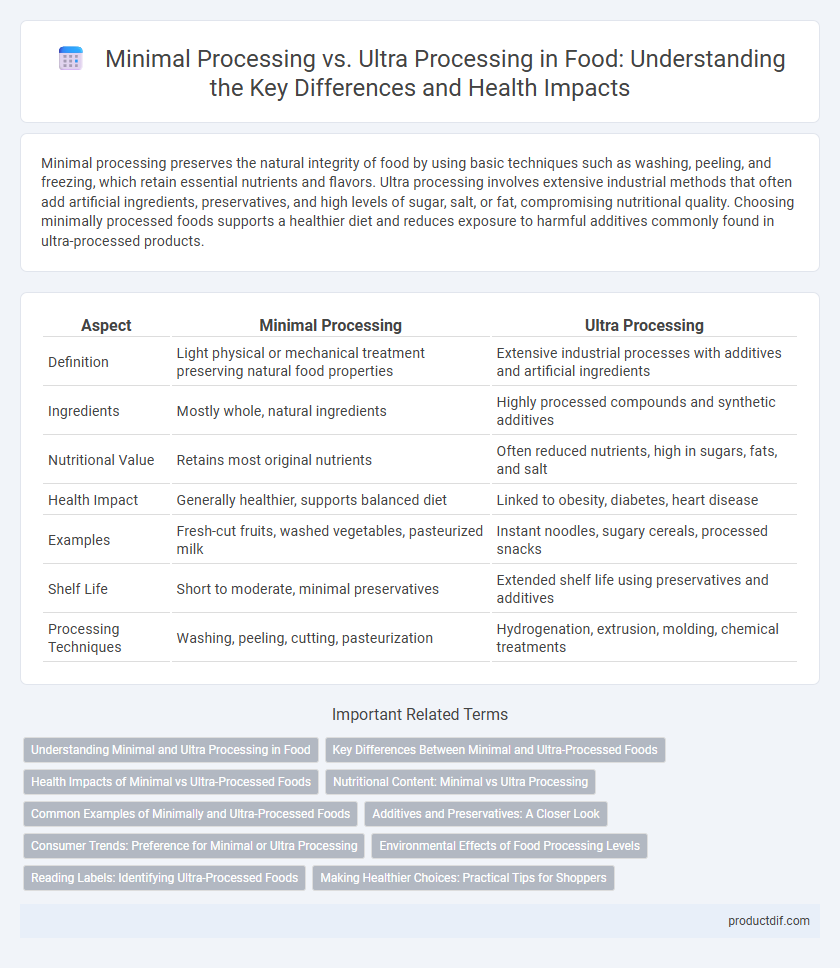Minimal processing preserves the natural integrity of food by using basic techniques such as washing, peeling, and freezing, which retain essential nutrients and flavors. Ultra processing involves extensive industrial methods that often add artificial ingredients, preservatives, and high levels of sugar, salt, or fat, compromising nutritional quality. Choosing minimally processed foods supports a healthier diet and reduces exposure to harmful additives commonly found in ultra-processed products.
Table of Comparison
| Aspect | Minimal Processing | Ultra Processing |
|---|---|---|
| Definition | Light physical or mechanical treatment preserving natural food properties | Extensive industrial processes with additives and artificial ingredients |
| Ingredients | Mostly whole, natural ingredients | Highly processed compounds and synthetic additives |
| Nutritional Value | Retains most original nutrients | Often reduced nutrients, high in sugars, fats, and salt |
| Health Impact | Generally healthier, supports balanced diet | Linked to obesity, diabetes, heart disease |
| Examples | Fresh-cut fruits, washed vegetables, pasteurized milk | Instant noodles, sugary cereals, processed snacks |
| Shelf Life | Short to moderate, minimal preservatives | Extended shelf life using preservatives and additives |
| Processing Techniques | Washing, peeling, cutting, pasteurization | Hydrogenation, extrusion, molding, chemical treatments |
Understanding Minimal and Ultra Processing in Food
Minimal processing preserves the natural state of foods by applying techniques like washing, cutting, freezing, or drying, which maintain nutritional value and freshness without adding artificial ingredients. Ultra processing involves extensive industrial methods and the addition of preservatives, flavor enhancers, and artificial colors, often resulting in nutrient loss and higher levels of sugar, salt, and unhealthy fats. Understanding the distinction between minimal and ultra processing is crucial for making informed dietary choices that promote health and well-being.
Key Differences Between Minimal and Ultra-Processed Foods
Minimal processing preserves most of the food's natural state, involving simple methods like washing, freezing, or chopping to retain nutrients and flavor. Ultra-processed foods undergo multiple industrial techniques, including the addition of artificial ingredients, preservatives, and flavor enhancers, which significantly alter their nutritional profile. Key differences include nutrient density, ingredient complexity, and the presence of additives, with minimal processing prioritizing natural integrity and ultra-processing focusing on convenience and shelf life.
Health Impacts of Minimal vs Ultra-Processed Foods
Minimal processing preserves the natural nutrients, fiber, and antioxidants found in whole foods, supporting digestion and reducing the risk of chronic diseases like heart disease and diabetes. Ultra-processed foods often contain high levels of added sugars, unhealthy fats, and artificial additives, which can contribute to obesity, inflammation, and metabolic disorders. Consuming primarily minimally processed foods promotes better overall health outcomes by maintaining nutrient density and minimizing exposure to harmful substances.
Nutritional Content: Minimal vs Ultra Processing
Minimal processing preserves the natural nutritional content of foods, maintaining higher levels of vitamins, minerals, and fiber. Ultra processing often leads to nutrient depletion and the addition of artificial ingredients, sugars, and unhealthy fats. Consequently, minimally processed foods support better health outcomes by retaining essential nutrients and reducing exposure to additives.
Common Examples of Minimally and Ultra-Processed Foods
Minimally processed foods include fresh fruits, vegetables, nuts, and plain yogurt, which retain most of their natural nutrients and require little alteration from their original state. Ultra-processed foods encompass items like sugary cereals, packaged snacks, instant noodles, and soda, characterized by multiple added ingredients such as preservatives, flavor enhancers, and artificial colors. Choosing minimally processed foods supports a diet rich in whole nutrients, while high intake of ultra-processed foods is linked to increased risks of obesity, diabetes, and cardiovascular disease.
Additives and Preservatives: A Closer Look
Minimal processing involves limited use of additives and preservatives, aiming to maintain the natural state of food with simple techniques like washing, cutting, or refrigeration. Ultra-processed foods contain numerous additives such as artificial flavors, colorants, emulsifiers, and preservatives designed to enhance taste, texture, and shelf life but often reduce nutritional quality. Research links excessive consumption of ultra-processed foods to health risks due to high levels of synthetic additives and lower nutrient density compared to minimally processed options.
Consumer Trends: Preference for Minimal or Ultra Processing
Consumer trends increasingly favor minimally processed foods due to growing awareness of health benefits and ingredient transparency, driving demand for fresh, natural products with fewer additives. However, ultra-processed foods continue to attract consumers seeking convenience, long shelf life, and bold flavors enabled by advanced food technologies. Market data reveals a shift towards balanced options that combine minimal processing benefits with enhanced convenience and taste.
Environmental Effects of Food Processing Levels
Minimal processing preserves natural food structures, reducing energy consumption and waste compared to ultra processing, which often relies on extensive industrial techniques and packaging materials that increase carbon footprints. Ultra-processed foods contribute significantly to environmental degradation through intensive resource use, high greenhouse gas emissions, and plastic pollution from packaging. Choosing minimally processed foods supports sustainability by minimizing environmental impact and conserving biodiversity.
Reading Labels: Identifying Ultra-Processed Foods
Ultra-processed foods often contain long ingredient lists with additives such as artificial flavors, colorings, preservatives, and emulsifiers, which can be identified by reading product labels carefully. Minimal processing retains the natural structure and nutrients of food, typically listing few, recognizable ingredients like fruits, vegetables, or whole grains. Understanding these distinctions on labels helps consumers make healthier choices by avoiding substances associated with ultra-processed products linked to chronic diseases.
Making Healthier Choices: Practical Tips for Shoppers
Choosing minimally processed foods like fresh fruits, vegetables, whole grains, and lean proteins supports better nutrition by preserving natural nutrients and limiting added sugars, salts, and unhealthy fats. Shoppers should prioritize products with short ingredient lists and recognizable components, avoiding ultra-processed items high in preservatives, artificial flavorings, and refined carbohydrates. Reading nutrition labels carefully and selecting items with fewer additives helps maintain a balanced diet and reduces the risk of chronic diseases linked to poor dietary choices.
Minimal Processing vs Ultra Processing Infographic

 productdif.com
productdif.com